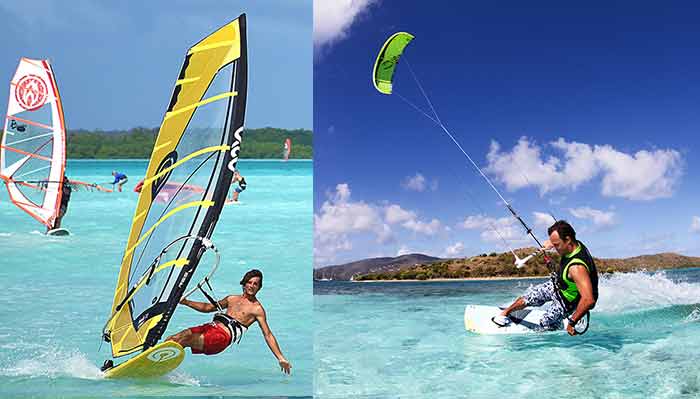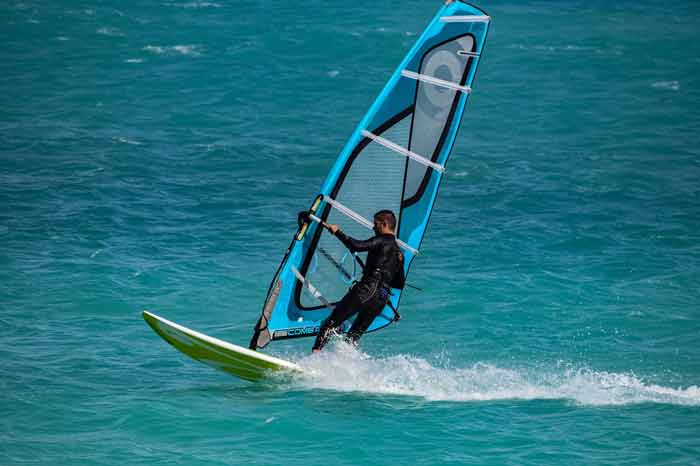Windsurfing Boards + Beginner, SUPs & Types Guide
To master the art of windsurfing, you need not only the perfect skill-set but also a windsurfing board of the right size, shape and type.
With the correct gear set, learning and surfing at any level and condition will be quick, smooth and enjoyable.
windsurfing boards range from the traditional wood boards, modern windsurf foil boards and Wind-SUP Crossover boards.
Following are details of the best board types & brands for beginners, intermediate and advanced windsurfers including buying guide with board parts and used board ideas.
Best Windsurfing Boards for Beginners
If you’re beginning windsurfing, all you need is stable board that will reduce falling off. This calls for boards with large widths (about 70cm to 100cm) and higher volumes of between 140L to about 200L
For comfort and minimal injuries, soft material boards are also a better choice for newbies who are not used to sailing on the boards.
If you’re an adult beginner, the design and size you go for may depend on your weight. In the case of kids, the choice greatly depends on the age and perhaps weight. Soft surfboards for kids help them gain and build their confidence. Choose a board that is easy to control making your sailing more exciting.
Go for boards with retractable daggerboards since these are fast, easier and convenient to manage.
Following is a list of the most popular top beginner windsurfing boards.
Windsurfer LT
This board maintains what the original 70’s & 80’s board offered but with a couple of modern enhancements including;
- Retractable daggerboard
- Full EVA deck
- Light and stiff construction
- Power box fin system
- Modern mast box.
It is best for light to moderate wind use. It is a good option for learners and advanced windsurfers who want refresh their old-school skills.
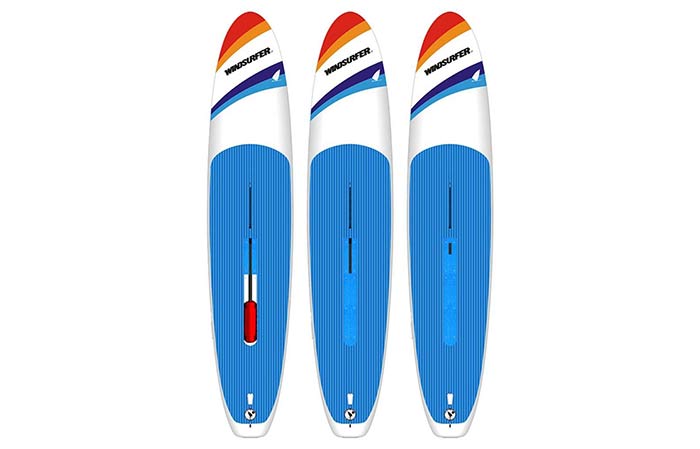
This design is faster and lighter and it comes in 3 versions based on same hull; SUP, Freestyle and Race. The Freestyle is the best all rounder for windsurfing and SUP use.
BIC Sport Tough-Tec Beach Windsurfer
It has a modern wide shape for stability to enhance performance
This board is perfect for both newbies and intermediate windsurfers of all sizes. It comes with a retractable dagger board for exceptional upwind performance in all conditions.
Durable “tough-tec” polyethlyene construction and a padded deck for comfort and a slip free surface

Other beginner boards
Others include;
- 2019 Bic Techno 185D
- RRD Evolution Softskin Y25
- 2019 Exocet’s Link M and Link L
- 2019 Fanatic Viper Soft Deck
SUP Windsurf Boards (Wind-SUP Crossover Boards)
These are basically SUPs (Stand Up Paddle) boards that can be used for windsurfing.
These are perfect for individuals and families looking for windsurfing and standup paddling capabilities where there’s no or limited wind.
These boards come in two versions;
Inflatable WindSUP
These boards allow for a very compact SUP that requires little storage/transport space. The board, board parts and pump all fit inside a backpack type of bag making ideal for travel.
You can use these inflatables for both windsurfing and standup paddling activities.

Rigid Structure WindSUP Boards
These are usually rigid light-weight and durable boards that are designed for windsurfing in light to moderate wind conditions. These boards are created using method called AST (Advanced Sandwich Technology)
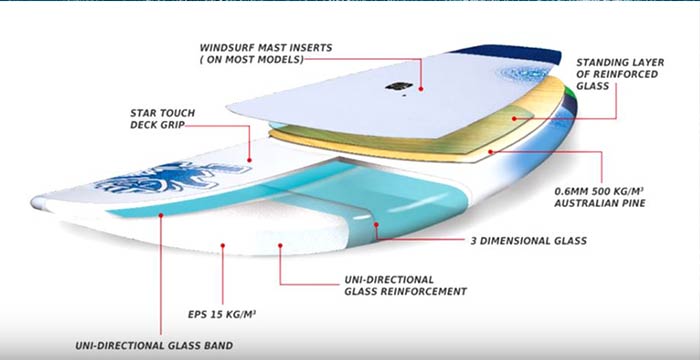
The size of these boards varies in width and length. They include large surface daggerboards and a few models have sliding mast track options.
This design combination helps maximize upwind pointing capabilities and speed. They’re great for cruising around, exploring, light wind freestyle, recreational racing, and in some case provide excitement of small wave riding.
Following is a video review of the best WindSUPs by isthmus representative.
Windsurf Foil Boards
Windfoiling is some form of modified and exciting windsurfing. It involves Special designed and reinforced windsurfing boards which are combined with specific windsurfing Hydrofoils designed to enable boards to foil and fly in as little as 6 knots of wind.
The unique FOILS (Hydrofoils) are designed to lift a windsurfing boards out of the water, meet a path of least resistance and provide a flying sensation to the rider
One of the most popular in this category is slingshot windsurf foil board. Following is a video demo of slingshot
Top Windsurfing Brands
Some of the top brands and manufactures of windsurfing boards include
- Starboard
- Exocet
- RRD(ROBERTORICCIDESIGNS)
- BIC Sport
- Tabou
- JP
- Fanatic
- Kona
- Horue
- Slingshot
Buy Guide: Parts & what to look for
Windsurfing is a surface water activity that incorporates both the act of sailing and surfing. This activity is normally facilitated by a board commonly known as windsurfing board.
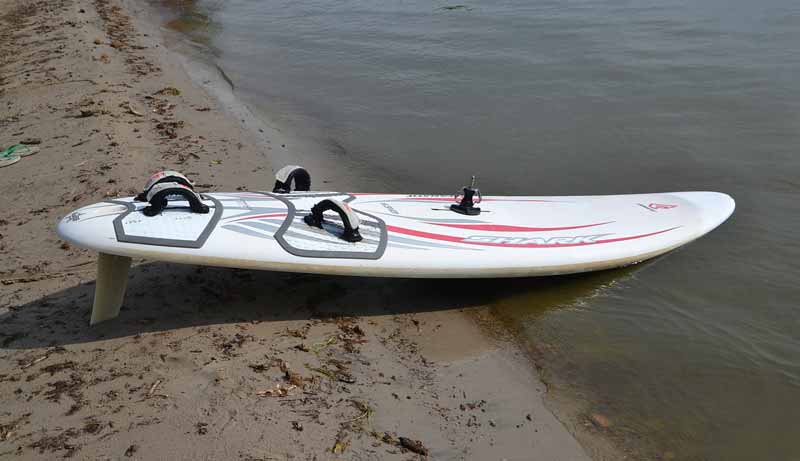
Sailing involves wind which act on the sails or rigs therefore pushing the entire board on the water surface. Surfing comprises the surfer who is normally the rider and carries on the activity on the surface or deep part of a moving wave propelling the sail towards the shore of either the ocean or sea.
A wind surfing board is usually of two to four meters long and is powered by the orthogonal effect of wind. The board has a capacity equivalent to displacement of about 45 and 150 liters. It is also made of a rig attached to the board by a free rotating universal joint with a mast, boom and a sail.
Windsurfing Board Parts
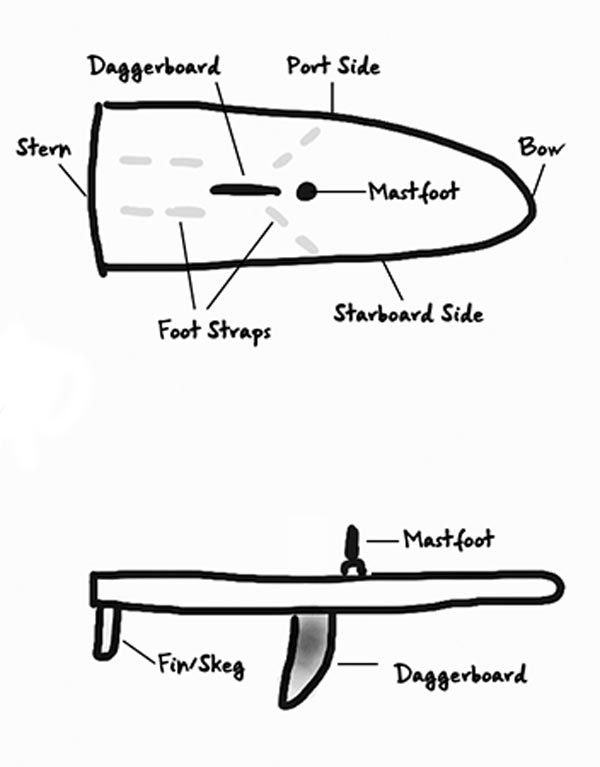
Normally, the area of a sail ranges from 1.5 to 12 square meters depending on how skilled the rider is as well as the sailor’s weight.[1]
Depending on the type, different material are used to make these boards some the materials include; expanded Polystyrene foam, epoxy, fiberglass, polyvinyl chloride or carbon sandwich. The cost of the board depends on many factors such as size, design and materials from which it is made etc.
What to look for when Shopping
The choice of a windsurfing board depends on the following:
Volume
Generally, the volume of a dashboard is estimated based on the amount of water it can displace before it begins to submerge. Research findings show that 1 liter of water floats on 1 kilogram of weight.
You are advised to first know your weight before purchasing any board so as to act as a guide on the volume of your board to be purchased. Additional 50 to 100 kilograms are highly recommended for a beginner. Therefore, for instance, if you weigh 60 kilograms then a board with the range of 110 to 160 liters is the most suitable.
Note that, the more the volume of your board; the more stable it will be. This makes it easier for you to balance it in the sea. Though, you are urged to adjust the volume of the board as you progress and become a better rider who can deal with stronger winds at high speeds while still giving a room for enough volume for up hauling.
Using a high volume board poses a great challenge since as you progress and learn more in a higher level, it becomes difficult to control the equipment in regions with high winds especially when riding at high speeds.
Width
Normally, the wider the board the more stable it is and it will be easier for you to learn on how to ride faster. However, you are advised to consider boards with medium width as too wide boards (in the class of formula category) are designed for unique categories of competition.
Fin
These are usually located at the bottom of the board. They play a role of generating lift and controlling the direction of movement. Normally, a big fin generates great lift which is essential for great sails and strong winds.
However, for less experienced windsurfers, you are highly encouraged to use boards with small fins. This is so to prevent occurrence of accidents in times of strong winds.
Mast box
This refers to a board component that connects your rig to the board. It is made up of a slotted channel in the board deck and makes the skeleton of the windsurfer. Typically, it is an essential component of the board, since its structure allows propulsion by the wind at high speeds exceeding 50 knots.
You are therefore advised to choose one that has a suitable stiffness in the range required or recommended by the sail maker. This is measured by supporting the mast at each end and applying weight of about 30 kilograms at the center of the mast.
Bigger sails require stiffer masts to support the excess forces. You are also required to put into consideration the shape of the bend curve as it also plays an important role in the board.
Foot straps
Just as the name suggests, foot straps are used for fitting the feet when the board is planing. They are suited to retain stability when using a harness.
Dagger board system
This refers to rectangle fin positioned in the middle of the board, especially in cases of beginners or middle level boards. It is usually adjustable while windsurfing to a range of between 0 to 90 degrees depending on the conditions.
Sometimes, the fin is usually downwards to help increase stability and reduce chances of drift. You are however urged to fully retract it to the bottom of the board so as to help you achieve higher speed.
Used Boards & Renting
Owing to the fact that some windsurfing boards quite expensive, it is to strange to look for a used board or rent. The truth some shops rent boards and while others sale used boards.
In fact, renting a board is one of best hacks to get yourself the right board. Renting means that you will have an opportunity try a couple of board, types, designs and sizes. This is a good idea especially if you’re just starting. For advanced users who already know what they want, it may not be a good idea.
Buying used boards isn’t something anyone of sound would recommend. It would make sense if you know the seller you’re intending to buy from has good reputation or at least if you have the technical know-how to tell the condition of the board.
Board Types & Classification
Back in the 1970s, windsurfing boards were classified into two categories; short and long boards. The latter were of around 3 meters with a rectangular centerboard used by most sailing craft and were commonly used during lighter winds.
On the other hand, short boards were less than 3 meters. They were optimized for operating in planing conditions. It is believed that, a variety of the modern types of the boards are as a result of development and innovations made on the short boards.
Most of the windsurfers prefer surfing during times when you can plan consistently with multipurpose. Occasionally, regions such as North Carolina are mostly occupied by windsurfers simply because the required sailing conditions are available on regular basis.
Today, these boards are classified into various categories which include the following;
Wave boards
Normally, they are smaller, lighter and best boards to use when breaking waves. In addition, they contain a capacity of around 60-85 liters and length ranging between 240-275 centimeters.
However, these dimensional have been altered by increasing the wave board’s width and decreasing its length. It is believed that this enables the wave surfers have an easy time of operating the boards on their different abilities.
Freestyle boards
These are almost similar to wave boards, however; they are wider and have a greater capacity which is specified for carrying out acrobatic tricks. Ideally, they are used on flat waters.
This comprises pulling of jumping tricks and combining sail and board rotations. It is a very interesting type of windsurfing technique to watch and see how much you can maneuver different styles to come up with a solid and consisted trick using a sail and a board.
Racing Lon Boards
Racing long boards, commonly known as Mistral One Design. They are usually of different designs, shape and sizes.
Mistral one Design Class was chosen for use in the Olympic back in 1996, which was later replaced by the RS: X in 2004. Typically, they are light and tough and can be sailed in wind speeds of between 5 -35 knots with regard to the conditions at the sea.
Speed Boards
They are a narrowed slalom board that is made for very high speeds only. They come with all sizes of up to 60cm wide. You are advised to use this type of boards when you need to sail at very high speeds. However, this is not recommended for beginners.
Formula windsurfing class boards.
This refers to a high concert racing competition surfboards, with high range of wind which makes it possible to compete in winds from 7 to 35 knots unlike the Olympic class which operates in the range of 30 to 33 knots.
The Formula windsurfing board is different in that it uses Bullet Nose design and attacks at a low angle for minimal nose drag. Thereafter, it accelerates faster and quickly out of the jibes and then back on the plane. The rocker flat is designed in such a way that it can accelerate to the maximum speed in any given condition.
Olympic windsurfing class
This was developed in the year 2004 and produced 2005 by Jean Bouldoires. This was as a result of the successful bid by Neilpryde to supply one design windsurfing equipment to be used in 2008 Olympics in China. It was made to replace the Mistral One Design class.
The equipment comprised of a high level technology rig with mast and boom and a wide style board that made it easier for the competitions to be held in any condition.[2]
Its stability provides a high concert locked in feel in planing conditions. However, it also performs in non planing conditions due to its light weight and high performance.
RS: X allows for the participation of both men and women hence attracting the best windsurfers to the event.
Others
Other class of windsurfing boards is the Slalom type, which contain a variety of fins of length between 36 and 40 centimeters. Its outline is usually wide and between the foot straps for early and easy planing. Although, the planning surface behind the back foot is narrow for low drags and higher speeds.[3]
There are normally two formats of this type. There is a normal sail as any of the other types that contains a circuit where a great number of windsurfers compete to reach the destinations first.
Secondly, there is the other format in which the sailors pass through individual channels or ways. Here, each person strives to attain maximum speed that is recorded and compared with that of the colleagues to determine the winner.
The Slalom type uses isonics ‘low nose’ concept to minimize drag and boost control. It comprises thin profile for wind range, a deck concave which is used in controlling the board. Additionally, it is designed in a more vertical position made for sailing which blocks the space between the deck of the board and the sail.
References
[1] http://www.windsurfing-academy.com/information_bank/history/interview_with_jim_drake.asp
[2] http://www.rsxclass.org/rsx-class-2/about/
[3] http://www.star-board-windsurfing.com/2018/boards/2018-formula-one-slalom-one/

